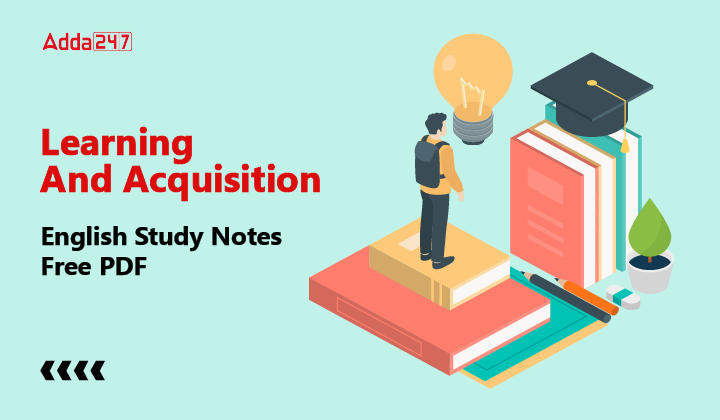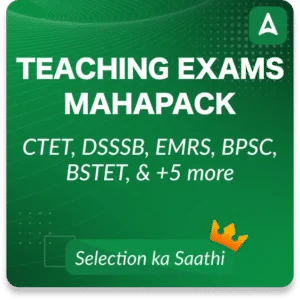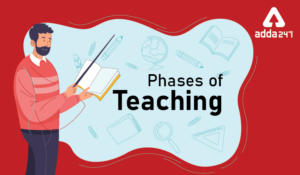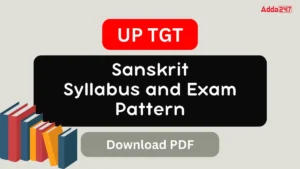Table of Contents
In many teaching exams including CTET and other State TETs etc. English languages play a vital role in the CTET and Other State Exams as candidates have to answer 30 questions in total in every such exam. In these exams, candidates need to face 15 questions of English content and 15 questions of English Pedagogy in each paper. To help candidates tackle English Pedagogy, we have come up with high-quality study material for the candidates. In the following article, the candidates will find all the relevant information on one of the most important topics of English Pedagogy- Learning and Acquisition.
LEARNING AND ACQUISITION
Learning and acquisition are two fundamental processes through which individuals acquire and develop language skills. These terms are often used in the context of language learning, but they can also apply to various other forms of learning. Let’s explore the definitions and concepts of learning and acquisition.
(1) Concept of Learning
Learning is a process of acquiring new skills or knowledge and improving the existing skills also. An individual undergoes a change in his/her knowledge and behaviour on account of learning. Everyone is different from one another in acquiring skills, which means everyone has a different rate or speed of learning. Certain factors such as environment, learner’s ability and motivation, teacher’s capabilities and ways of imparting knowledge all impact a person’s learning experience.
The Critical Period: The hypothesis states that the first few years of life constitute the time during which language develops readily and after which language acquisition is much more difficult and ultimately less successful.
(A) Types of Learning
1. Motor Learning: Most of our activities in day-to-day life refer to motor activities e.g. walking, running, driving, climbing etc. All these activities involve muscular coordination.
2. Verbal Learning: This type of learning involves the language we speak, and the communication methods we adopt e.g. signs, pictures, symbols, words, sounds etc are the tools used in such activities.
3. Conceptual Learning: in this form of learning, we require higher-order mental processes like thinking, reasoning, and intelligence. With the use of these, the child learns different concepts.
(B) Factors Affecting Learning
(1) Factors Related to Learner
• Learner’s motivation determines the intensity of learning.
• Learner’s efficiency or mental capacity.
• Learner’s interest and aptitude towards the subject.
• Learner’s general health.
• Learner’s attention, readiness and willpower.
(2) Factors Related to Teachers are
• Teacher’s command over the subject.
• Teacher’s way of communicating,
• Teacher’s personality and attitude towards learners.
• Teacher’s behaviour with students.
(3) Factors Related to the Environment, Teaching Materials and Human Resources are
• Conducive environment to learning.
• Structure and size of classrooms.
• Availability of appropriate subject material to facilitate the learning process.
• Home environment of the learner.
(2) Concept of Acquisition
When language is learned naturally and without any systematic practice, it is called acquisition. The term ‘learning and acquisition’ are complementary. Learners acquire language when it is used in a natural environment.
(A) Language Acquisition
• Language acquisition is the process by which humans acquire the capacity to perceive, produce and use words to understand and communicate.
• This capacity involves the picking up of diverse capacities including syntax, phonetics and an extensive vocabulary.
• This language might be vocal as with speech or manual as in sign.
• Language acquisition usually refers to first language acquisition, which studies infants’ acquisition of their native language, rather than second language acquisition, which deals with the acquisition (in both children and adults) of additional languages.
• The capacity to acquire and use language is a key aspect that distinguishes humans from other organisms. While many forms of animal communication exist, they have a limited range of non – syntactically structured vocabulary tokens that lack cross-cultural variation between groups.
(B) Concepts Associated with Acquisition and Learning
(i) Piaget’s Concept: This concept states that learning starts with adaptation, assimilation and accommodation. He also said that classification was also important to learning a language.
• Certain words and sounds needed to be grouped together to better understand and use them in speech.
• Through assimilation, the learner takes the information and changes it to make it suitable for him.
(ii) Concept of Chomsky: Chomsky states that every person possesses a Language Learning Device or (LLD) which is a hypothetical tool hard-wired into the brain.
• It helps children rapidly learn and understand a language.
• He also states that all children are born with an understanding of the rules of language; they simply need to acquire vocabulary.
(iii) Vygotsky’s Concept of Learning and Acquisition: Vygotsky was of the opinion that social interaction played an important role in the development of cognition.
• According to him, ‘community’ also plays a central role in the process of making meaning and learning is a necessary and universal aspect of the process of developing culturally organized, specifically human psychological function.
• In other words, higher mental processes in the individual have their origin in social processes. He places more emphasis on the role of language in cognitive development.
(iv) Pavlov’s Concept of Learning: Pavlov propounded a new theory of learning known as Classical Conditioning, according to him classical conditioning is a reflexive or automatic type of learning in which a stimulus acquires the capacity to evoke a response that was originally evoked by another stimulus.
• ‘Classical conditioning’ is based on habit formation Pavlov was of the view that humans learn due to some stimulus.
(3) Language Development in Children
Communication between people who know each other and respect each other is one of the most important factors in the language development of a child.
Children need to learn a language in order to understand things around them.
It is through language that they express their feelings and communicate with others. With the development of language only, children are able to represent and express new ideas and complex matters also. When children are not able to put their feelings into words, they are very disturbed and this situation can reduce or damage their self-esteem.
(A) Initial Stage of Language Development
The desire to communicate starts at birth. Babies learn quickly how to get their needs met by crying, cooing and making eye – contact with their immediate family.
• A child’s overall development and mental health are affected greatly by his ability to communicate in a variety of ways.
• Words are the most important tool through which a child gets connected to his family as well as to the rest of the world.
• Through words only a child stores information and parts with his feelings and experiences.
• Children as young as 3 years of age already possess a remarkable knowledge of language structure and syntax which is so complex and precise that it must challenge any known learning theory to account for its acquisition.
(B) Actual Stage of Language Development
The initial years of childhood can be called preparation time for learning a language.
• The language development starts with the oral expressions that a child uses to express himself. He / She learns a language through words, sentences and then complex structures.
• After a child starts going to school, the child develops the ability to read as well as write. Slowly, the child becomes proficient in all types of learning skills from listening and speaking to reading and writing.
• Language development thus helps him not only in using language as an expression tool but through proficiency in language the child becomes knowledgeable and changes into an all-developed personality.
(C) Development of Vocabulary
In the initial years of growing up child’s vocabulary also grows manifold. Children typically understand or recognize more words than they usually speak.
When the child is one or one and a half years old, he understands more words than he speaks.
Table showing vocabulary of children in different age groups:
The following table shows the vocabulary of children throughout their life based on their age group.
| Children’s Age | Children’s Vocabulary |
| From birth to 8 months | 0 |
| From the 9th month to one year upto one and a half years | Three to four words 10 to 12 words |
| Up to 2 years | 272 words |
| Up to 2 years to 6 months | 450 words |
| Up to 3 years | 1000 words |
| Up to 3 years and 6 months | 1250 words |
| Up to 4 years | 1600 words |
| Up to 5 years | 2100 words |
| Up to 11 years | 50000 words |
| Up to 14 years | 80000 words |
| 16 years+ | More than 1 lakh (million) words |
(D) Vocabulary Learning
The vocabulary learning of a child in different age groups is shown below-
• Child reaches school age and heads to kindergarten, he/she will have a vocabulary of around 2000 words. Talking and reading are very good sources of vocabulary development in a child.
• Parents or other family members must talk to the child about his/her day at school, about teachers, about books she/he checked out at the libraries or something funny that happened at school etc.
• It is important to encourage children’s vocabulary development so that they develop the language and literacy skills necessary to succeed in school.
(E) Strategies to Increase Vocabulary
Some tips or strategies to increase a child’s vocabulary are as follows
• Follow your child’s lead. If parents talk about what interests the child, he/she may pay attention and learn new words.
• Don’t bombard one child with new words the child should be given time to make a response and use his/her vocabulary to express feelings.
• Children need to hear a word repeatedly. Along with speaking new words, some actions or gestures should follow. It really helps in acquiring new words easily.




 Phases of Teaching - Stages of Teaching ...
Phases of Teaching - Stages of Teaching ...
 स्वर व व्यंजन - �...
स्वर व व्यंजन - �...
 UP TGT Sanskrit Syllabus and Exam Patter...
UP TGT Sanskrit Syllabus and Exam Patter...




